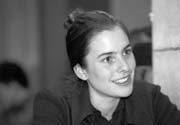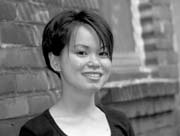

 |


Elsa Rossignol: Humanitarian in the house
Ask Elsa Rossignol how she feels about being nominated for the YWCA's Young Woman of Distinction Award and she's quick to point out that she wasn't alone in founding the Students' Association for Medical Aid that is her main claim to fame right now. "The only reason Jean-Sébastien Joyal [SAMA's co-founder and a fellow medical student] wasn't nominated is that he's not a woman," she says with humility.
Still, she's pleased that Associate Dean of Medicine (Medical Education and Student Affairs) Dr. Donald Boudreau nominated her because "it indicates that the Faculty of Medicine supports SAMA and it gave me a boost to continue." That's important to Rossignol because she wants the humanitarian aid organization that she co-founded three years ago to keep growing.
Boudreau sees SAMA as "a great way of continuing a tradition of linking medical students to local and worldwide communities. Also, it's a humanitarian project. We want to nurture the humanitarian motivation in medicine."
SAMA sends medical and dentistry students to poor and/or war-torn countries to provide humanitarian aid, such as distributing supplies in refugee camps and helping in orphanages. Through carwashes and other events, SAMA members also raise funds and solicit materials for the countries they work in -- basic items such as antibacterial soap and school supplies are often desperately needed in these countries.
In the first year, SAMA volunteers went either to Croatia or Armenia. Today, the 20-member organization also has projects in Haiti, Vietnam and the Philippines. The students raise their own money for travel, language courses, vaccinations and, sometimes, lodgings.
"My hope for the organization was that it would give students in the healthcare field the opportunity to work overseas, to see how others perceive things," says Rossignol. "I also wanted to understand what happens in time of war."
Rossignol got a taste of the ravages of war while working for three weeks in a Zagreb orphanage for refugees of the war in the former Yugoslavia.She and three other SAMA members were welcomed with open arms by the overburdened women running the operation, which comprised eight buildings, each housing 25 children.
"We took the kids to a pool, did music with them, theatre and art. Last year, the group brought materials to set up an arts and crafts room." Rossignol has particularly fond memories of a little girl with cerebral palsy whom she took to the pool every day. It was the girl's first such experience and "she loved it." Leaving the girl behind to return to Montreal was wrenching, Rossignol says.
Being involved in SAMA has taught Rossignol how vulnerable a society can be to war breaking out. "I'm very sensitive to violence now. I saw how it takes nothing to spark violence. I now see it as a possibility and something we must watch out for."
Rossignol, who is considering specializing in pediatrics and would like to work in different countries, says that this is her last year with SAMA. Before she leaves, she wants to encourage students from other health sciences fields such as nursing and physical and occupational therapy to become involved in the organization. "My hope is that we will be better healthcare-givers after an experience with SAMA."
Bronwyn Chester
|
 | Moo-ving up the rankings
|
 If the 75-cow herd at Macdonald Campus were listed on the stock exchange, last June would have been the time to invest. That was when animal science professor Elliot Block took over as director of the farm. Since then, the largely Holstein herd has moved from a ranking of 2,080th (out of 9,000 herds in Quebec) for the quality and quantity of milk produced, to an impressive ninth! The cows produce an average of 30 litres/day while the average Quebec milker produces approximately 21. If the 75-cow herd at Macdonald Campus were listed on the stock exchange, last June would have been the time to invest. That was when animal science professor Elliot Block took over as director of the farm. Since then, the largely Holstein herd has moved from a ranking of 2,080th (out of 9,000 herds in Quebec) for the quality and quantity of milk produced, to an impressive ninth! The cows produce an average of 30 litres/day while the average Quebec milker produces approximately 21.
Was it steroids, somatotropin, growth hormone, force-feeding?
No. Simply an improvement in diet and milking management, says Block.
"We did a complete feed analysis and balanced the ingredients in their diet," he says, explaining that the quality of hay and silage (grasses harvested from the field and left to ferment in silos) was improved and that more grains were added to the previous corn and soy meal diet. Now, in addition to those grains, the cows receive fish meal, wheat and distiller's grains (the leftover grains from the distilling of the likes of rye whiskey -- purchased from Seagram's, no less! -- bourbon and beer) which include rye, corn, hops and barley.
The other two parts of the winning formula include increasing the number of milkings per day from two to three and feeding the cows a consistent, generous amount, even when their milk production declines. This is done to ensure that cows gain back the weight lost when lactation first begins after calving. That way, says Block, overall milk production is higher.
Block has a vested interest in having his cows -- the subjects of several teaching and research projects -- produce as much top-quality milk as possible. His annual budget for the farm is $600,000, $500,000 of which is generated in revenues from the milk sold to the Dairy Producers of Quebec. Given the cuts he has already faced, Block is aiming to make his operation self-sufficient.
Is there a star milker in the herd? one wonders. "I think they're all stars," says a proud Block.
|
 |
The health food people will always have the answer. That's one measure of a quack. Science knows its limits. If it sounds too good to be true, it is too good to be true.
Joseph Schwarcz, an adjunct professor in the Department of Chemistry, quoted in The Ottawa Citizen. Schwarcz, obviously no fan of the health food movement, was speaking at a women's health conference.
|
 | A scribe for science
|

It's shaping up to be a pretty good year for the Reporter. In February, we picked up a gold medal in a university newspaper competition that covers Quebec, the Maritimes and the northeastern U.S. Now comes word that one of our writers has earned a national award.
Ellyn Kerr, who just completed her master's degree in cell biology, has won first prize in the annual student writing competition held by the Canadian Science Writers' Association. Kerr's prize-winning piece, about the work of McGill pain researcher Catherine Bushnell, was first published in the Reporter last fall.
Kerr was one of the talented science students who took part in our NSERC-sponsored science writing internship, a program modelled after a similar one at the University of Guelph which trains science students in writing for a general audience.
The students who took part in the Reporter's program came from a variety of disciplines -- physics, pathology, microbiology and immunology, chemical engineering and environmental geosciences. Their articles got noticed. Several pieces by the students were reprinted in other publications such as Future Health and the McGill University Hospital Centre's Ensemble. Their work led to follow-up pieces in YES magazine and on the Québec Science website.
Come summer, Kerr will be a student in Concordia University's graduate diploma program in journalism. She isn't certain she wants to be a journalist per se, but she is committed to marrying writing and science in her future career. "I know it sounds lofty, but I would love to be able to do what Oliver Sacks does," says Kerr of the best-selling author and neurologist, one of the best in the business at popularizing science.
Kerr says the Reporter program was a real boon for her writing ambitions. "I had the chance to talk to interesting scientists and to interview people like Oliver Sacks and John Horgan [author of the controversial The End of Science]. I was able to work directly with the editors and really learn from them. I wouldn't just hand in an article, have them correct it and see something totally different from what I wrote printed. They gave me feedback and worked with me and I appreciated that."
It's been nice working with you too, Ellyn.
|
 |
In the early '60s, I thought that being an astronaut was really everything that I wanted to do....I think for my kids my message would be: 'Have a dream and don't feel badly about having a dream, and hang in there....If you really work hard and you really believe in what you're dreaming, then maybe it will come true as well.
Canadian astronaut Dr. Dafydd Williams, speaking to The Toronto Star. Williams, who holds appointments in McGill's Departments of Surgery and Family Medicine, blasted off into outer space last week as part of the crew of the space shuttle Columbia. Accompanying him into orbit was the Wood Gold Medal he won as a McGill medical student for displaying outstanding clinical skills, as well as the logo of the Montreal Neurological Institute.
|
|



